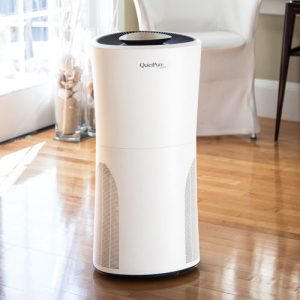Where, and How, to Buy an Air Purifier

There’s no doubt about it: Americans spend a lot of their time indoors. (According to the Environmental Protection Agency, up to 90%!) Between work, sleep, Netflix bingeing, cooking, shopping and errand-running, we’re within the confines of four walls a vast majority of our day. What does that mean? It means that there’s a good chance the air we’re breathing isn’t properly ventilated, isn’t fresh, and could very well be recirculating a lot of unsavory things we’d rather not think about. We’re a society moving further and further indoors, and so becoming more in tune with our surrounding indoor air quality seems like a natural direction to begin thinking.
What Makes Up Air Quality?
The EPA says that indoor air quality (IAQ) refers to the quality of air within and around buildings and structures, especially as it relates to the health and comfort of building occupants. OSHA (Occupational Safety and Health Administration) explains it further, stating that “indoor air quality (also called “indoor environmental quality”) describes how inside air can affect a person’s health, comfort, and ability to work.” Numerous factors can impact indoor air quality, like emissions, moisture levels, biological factors (like pets), HVAC functionality, housekeeping routines, furnishings, natural disasters, ventilation and weather.
Factors That Impact Your Indoor Air Quality
Bearing in mind all the factors that play into one’s personal indoor air quality, there are ways to reverse unhealthy levels of contaminants, mitigate odors and remove unhealthy allergens and particulate in the air that can affect your health and wellness. Changing up your cleaning methods, controlling moisture levels, avoiding smoke (tobacco and wood), and rethinking the levels of chemicals and synthetic fragrances used throughout your indoor space can all have a positive impact on your indoor air quality.
In addition to those changes, you can also turn to technologies that solve for certain obstacles that many homeowners commonly face. For example, if excess moisture is a problem for you, choosing the right dehumidifier (or even an air purifier/dehumidifier combo unit) can be a great idea. Air purifiers in general can work as great solutions for families who are dealing with indoor air quality issues — whether they’re caused by odor, lack of circulation, urban pollution seeping indoors, pets, environmental conditions or chemicals/off-gassing. There are all kinds of air purifiers that are specially designed to tackle the source of your indoor air quality concern.
Finding the Right Air Purifier
Before you go out and buy the first air purifier you see, it can be helpful to do some research first. Determining what the major contributors of your IAQ concerns are can help you pinpoint exactly what kind of unit you’ll need. Also consider the amount of square footage you’ll need to cover; depending on the size or number of rooms, you might need more than one unit. Investigating brands, reading reviews and being able to ask for expert advice is always incredibly helpful and can positively influence your buying decisions.

The QuietPure Home air purifier is a great all around air purifier that improves indoor air quality but does it very quietly.
|

QuietPure Whisper air purifier The QuietPure Whisper is a great all around air purifier with whisper level noise levels.
|

Blueair Pro L has great styling and HEPAsilent technology making it a great investment for those looking for a high quality air purifier in a stylish package.
|

IQAir HealthPro Plus air purifier The IQAir HealthPro Plus is the top rated are air purifier in the industry and has 3 stage filtration.
|




